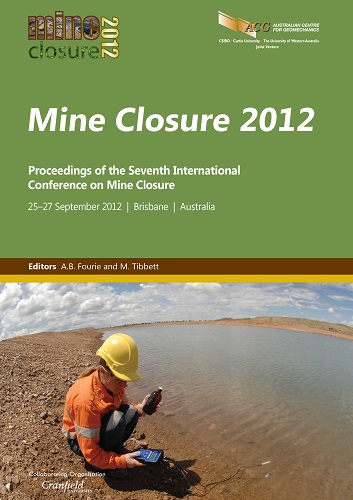Tailings reclamation trials at PT Freeport Indonesia in Mimika, Papua, Indonesia

|
Authors: Puradyatmika, P; Prewitt, JM |
DOI https://doi.org/10.36487/ACG_rep/1208_17_Puradyatmika
Cite As:
Puradyatmika, P & Prewitt, JM 2012, 'Tailings reclamation trials at PT Freeport Indonesia in Mimika, Papua, Indonesia', in AB Fourie & M Tibbett (eds), Mine Closure 2012: Proceedings of the Seventh International Conference on Mine Closure, Australian Centre for Geomechanics, Perth, pp. 173-186, https://doi.org/10.36487/ACG_rep/1208_17_Puradyatmika
Abstract:
Tailings produced by PT Freeport Indonesia (PTFI) operations are deposited in a designated area of 230 km2 in the lowlands of Mimika Regency of the Papua Province of Indonesia. To minimise lateral impacts, PTFI built and maintains two levees along the east and west sides of the deposition area. The area between the two levees is known as Modified Ajkwa Deposition Area (Mod-ADA). Currently research and development are ongoing to evaluate tailings reclamation approaches for eventual mine closure. There is an area in the western part of the Mod-ADA that is no longer actively receiving tailings as a result of the modification of the west levee. In this area trials are carried out as part of the reclamation program. At closure, the area where tailings are deposited can be divided into four zones, based on tailings particle size, geomorphology, hydrogeology and suitable vegetation types. The most appropriate conversion of inactive tailings deposition area into natural forest through natural succession process and re-vegetation or into productive agricultural uses varies depending on these zones. Tailings soil is classified as Entisolic and is characterised by low to very low content of nitrogen (N), phosphorous (P), potassium (K), and organic carbon and high calcium (Ca), magnesium (Mg), copper (Cu), iron (Fe), manganese (Mn), zinc (Zn), sulphur (S), and pH level ranging from medium to high (pH 6-8). The high pH level of tailings soil reduces mobility of nutrients and metals in soil solution and availability of these elements to plants. The tailings reclamation demonstration projects are carried out in an inactive former tailings area. Demonstrations and research projects include planting various agriculture crops, plantation crops and forest trees. In some areas primary natural succession is observed to successfully grow pioneer plants. The paper presents results of several of the trials including data on metal uptake in agricultural crops, growth and viability of forest plantation species, and the results of the natural succession process in re-establishing a high degree of biodiversity in a former tailings area. Approximately 160 plant species have been successfully grown on the former tailings deposition area. Laboratory tests performed on the edible parts of plants grown in tailings indicate that the metal content is below the maximum allowable limits of Indonesia Governmental Standard.
References:
Flach, M. and Rumawas, F. (eds) (1996) Plant Resources of South-east Asia No 9: Plants yielding non-seed carbohydrates, PROSEA, Bogor Indonesia, pp. 121–123.
Sanchez, P.A. (1992) Sifat dan Pengelolaan Tanah Tropika, Penerbit ITB Bandung Indonesia, p. 71.
Soerianegara, I. and Lemmens, R.H.M.J. (eds) (1994) Plant Resources of South-East Asia No 5(1): Timber trees: Major commercial timbers, PROSEA, Bogor Indonesia.
Sosef, M.S.M., Hong, L.T. and Prawirohatmodjo, S. (eds) (1998) Plant Resources of South-east Asia No 5(3): Timber trees: Lesser-known timbers, PROSEA, Bogor Indonesia, pp. 146–147.
Taberima, S. (2009) Soil development of mine tailings in ModADA PTFI : Reclamation and natural succession aspect, Disertation of Sekolah Pasca Sarjana Institut Pertanian Bogor, August 2009, pp. 60–63.
Turnbull, J.W. (1981) The use of Casuarina equisetifolia for protection forests in China, in Proceedings of an international workshop 1983, S.J. Midgley, J.W. Turnbull and R.D. Johnston (eds), 17–21 August 1981, Canberra Australia, CSIRO, Melbourne, p. 56.
Vossen, van der, H.A.M. and Umali, B.E. (eds) (2002) Plant Resources of South-East Asia No 14: Vegetable oils and fats, PROSEA, Bogor Indonesia, pp. 85–89.
Vossen, van der, H.A.M. and Wessel, M. (eds) (2000) Plant Resources of South-East Asia No 16: Stimulants, PROSEA, Bogor Indonesia, p. 51.
© Copyright 2025, Australian Centre for Geomechanics (ACG), The University of Western Australia. All rights reserved.
View copyright/legal information
Please direct any queries or error reports to repository-acg@uwa.edu.au
View copyright/legal information
Please direct any queries or error reports to repository-acg@uwa.edu.au